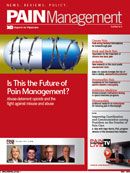Publication
Article
Pain Management
Is the Increase in Opioids Prescribed for Arthritis Pain in Elderly Patients Associated with an Increased Risk of Falls?
Several studies indicate there may be an increased risk of falls and fractures associated with the use of narcotic analgesics in elderly patients.
Research presented at the recent ACR/ARHP 2011 annual meeting (http://bit.ly/rsTd2W) suggested the possibility that, with the withdrawal of rofecoxib and valdecoxib from the market several years ago, clinicians may have increased their prescribing of opioid medications for their elderly patients suffering from chronic pain associated with arthritis, potentially placing these patients at increased risk for falls.
The authors also pointed to changes to treatment guidelines for pain in this population that favor the use of opioids. The American Geriatrics Society (AGS) clinical practice guideline “Pharmacological Management of Persistent Pain in Older Persons,” updated in 2009, notes that “In properly selected and monitored patients, opioid analgesics constitute a potentially effective and, for some patients, indispensable treatment as part of a multimodal strategy in the management of various types of persistent cancer and noncancer pain.” Thus, the guidelines strongly recommend that “All patients with moderate to severe pain, pain-related functional impairment, or diminished quality of life due to pain should be considered for opioid therapy” (http://bit.ly/sqbjuN). In a “significant departure” from the 2002 AGS guideline, the updated version recommends that “COX-2 selective inhibitors be considered rarely, with caution, in highly selected individuals” (http://bit.ly/rnMu7y).
The data presented at the ACR (derived from the records in the Geisinger EMR data warehouse of patients age 65 and older diagnosed with osteoarthritis from 2001-2009) looked at three groups: patients prescribed narcotic analgesics (NA) alone or with other analgesics, patients prescribed COX-2 drugs alone or with other analgesics, and patients prescribed NSAIDs or other medications. The authors reported that “patients receiving only NA prescriptions increased from 8% to 20% of the population and doubled again to 40% by 2009;” COX-2 usage remained at around 8% for this group over this time. The incidence of falls/fractures “increased from less than 1% of all patients in 2001 to 4% in 2009,” an increase which, the authors suggested, “appears to be associated with the increased use of narcotic analgesics.”
Increased risk of falls linked to opioid use in other studies
Other investigators have also noted the relationship between use of opioids and increased risk of falls in elderly patients with arthritis. The authors of “Opioid Analgesics and the Risk of Fractures in Older Adults with Arthritis,” noted that elderly patients may be more “susceptible to opioid-related cognitive and psychomotor effects, many of which are risk factors for falls” and fractures (http://bit.ly/uG5OaO). To assess this, they compared the risk of fracture associated with initiating opioids with that of NSAIDs in a cohort of Medicare beneficiaries with arthritis. They reported that patients initiating opioid therapy faced a “significantly higher” risk of fracture compared to patients on NSAIDs, and that “opioid use increases the risk of fractures in older adults with arthritis.” They also cautioned clinicians to “be alert to the possibility that short-acting opioids pose a significantly greater risk of fracture in older adults than do equianalgesic doses of long-acting opioids, especially during the first two weeks after initiating therapy.”
Other studies point to other possible causes
The authors of “Meta-analysis of the Impact of Nine Medication Classes on Falls in Elderly Persons” (http://bit.ly/sFg5e8) looked at the association between medication use and risk of falls in elderly patients and concluded that “the use of sedatives and hypnotics, antidepressants, and benzodiazepines demonstrated a significant association with falls in elderly individuals,” but did not find a significant association between risk of falls and narcotic use in this population. The authors of another article that examined this issue reported that independent risk factors for falls in elderly patients include decreased muscle strength, visual impairment, cognitive impairment, arthritis, and pain (http://bit.ly/uMoyrz). They also identified several classes of medications that have been associated with an increased risk of falls, including sedatives, antipsychotics, antidepressants, and benzodiazepines. However, the authors wrote that narcotics “have not been associated with increased risk of falls.”
“Cause-effect relationships of opioids and falls/fractures should be very cautiously inferred from data such as these.”
Use caution when making medication choices
Pain Management advisory board member Stewart Leavitt, PhD, writing about the ACR data at Pain-Topics.org (http://bit.ly/rGmrUB) reminds that “cause-effect relationships of opioids and falls/fractures should be very cautiously inferred from data such as these,” because there could be “other, unknown, factors accounting for either (or both) increased opioid prescribing and falls/fractures.” For example, Leavitt notes that “unrelieved pain in these patients due to inadequate analgesia might be a greater precipitating influence on falls and attendant fractures” than effects from opioids. Additional analysis of this and other data on the causes of falls in this population is warranted.






